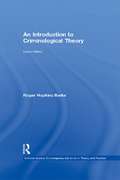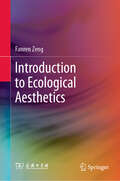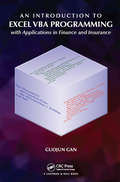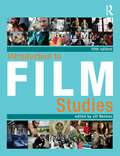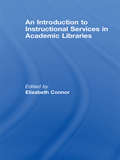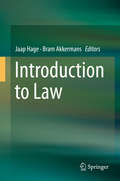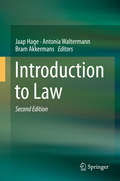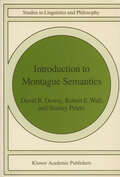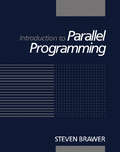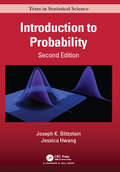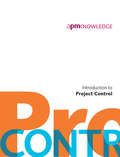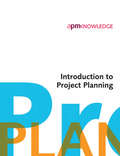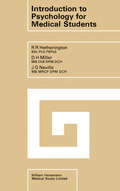- Table View
- List View
An Introduction to Criminological Theory (Criminal Justice: Contemporary Literature in Theory and Practice)
by Marilyn McShaneFirst Published in 1997. Routledge is an imprint of Taylor & Francis, an informa company.
Introduction to Ecological Aesthetics
by Fanren ZengThis book explores in detail the issues of ecological civilization development, ecological philosophy, ecological criticism, environmental aesthetics, and the ecological wisdom of traditional Chinese culture related to ecological aesthetics. Drawing on Western philosophy and aesthetics, it proposes and demonstrates a unique aesthetic view of ecological ontology in the field of aesthetics under the direct influence of Marxism, which is based on the modern economic, social cultural development and the modern values of traditional Chinese culture.This book embodies the innovative interpretation of Chinese traditional culture in the Chinese academic community. The author discusses the philosophical and cultural resources that can be used for reference in Chinese and Western cultural tradition, focusing on traditional Chinese Confucianism, Taoism, Buddhism and painting art, Western modern ecological philosophy, Heidegger's ontology ecological aesthetics, and British and American environmental aesthetics.In short, the book comprehensively discusses the author's concept of ecological ontology aesthetics as an integration and unification of ontology aesthetics and ecological aesthetics. This generalized ecological aesthetics explores the relationship between humans and nature, society and itself, guided by the brand-new ecological worldview in the post-modern context. It also changes the non-beauty state of human existence and establishes an aesthetic existence state that conforms to ecological laws.
An Introduction to Excel VBA Programming: with Applications in Finance and Insurance
by Guojun GanExcel Visual Basic for Applications (VBA) can be used to automate operations in Excel and is one of the most frequently used software programs for manipulating data and building models in banks and insurance companies. An Introduction to Excel VBA Programming: with Applications in Finance and Insurance introduces readers to the basic fundamentals of VBA Programming while demonstrating applications of VBA to solve real-world problems in finance and insurance. Assuming no prior programming experience and with reproducible examples using code and data, this text is suitable for advanced undergraduate students, graduate students, actuaries, and financial analysts who wish to learn VBA. Features: Presents the theory behind the algorithms in detail Includes more than 100 exercises with selected solutions Provides VBA code in Excel files and data to reproduce the results in the book Offers a solutions manual for qualified instructors
Introduction to Film Studies
by Jill NelmesIntroduction to Film Studies is a comprehensive textbook for students of cinema. This completely revised and updated fifth edition guides students through the key issues and concepts in film studies, traces the historical development of film and introduces some of the worlds key national cinemas. A range of theories and theorists are presented from Formalism to Feminism, from Eisenstein to Deleuze. Each chapter is written by a subject specialist, including two new authors for the fifth edition. A wide range of films are analysed and discussed. It is lavishly illustrated with 150 film stills and production shots, in full colour throughout. Reviewed widely by teachers in the field and with a foreword by Bill Nichols, it will be essential reading for any introductory student of film and media studies or the visual arts worldwide. Key features of the fifth edition are: updated coverage of a wide range of concepts, theories and issues in film studies in-depth discussion of the contemporary film industry and technological changes new chapters on Film and Technology and Latin American Cinema new case studies on films such as District 9, Grizzly Man, Amores Perros, Avatar, Made in Dagenham and many others marginal key terms, notes, cross-referencing suggestions for further reading, further viewing and a comprehensive glossary and bibliography a new, improved companion website including popular case studies and chapters from previous editions (including chapters on German Cinema and The French New Wave), links to supporting sites, clips, questions and useful resources. Individual chapters include: The Industrial Contexts of Film Production · Film and Technology · Getting to the Bigger · Picture Film Form and Narrative · Spectator, Audience and Response · Cinematic authorship and the film auteur · Stardom and Hollywood Cinema · Genre, Theory and Hollywood Cinema The Documentary Form · The Language of Animation · Gender and Film · Lesbian and Gay Cinema · Spectacle, Stereotypes and Films of the African Diaspora · British Cinema · Indian Cinema · Latin American Cinema · Soviet Montage Cinema of the 1920s Contributors: Linda Craig, Lalitha Gopalan, Terri Francis, Chris Jones, Mark Joyce, Searle Kochberg, Lawrence Napper, Jill Nelmes, Patrick Phillips, Suzanne Speidel, Paul Ward, Paul Watson, Paul Wells and William Wittington
An Introduction to Instructional Services in Academic Libraries
by Elizabeth ConnorMore than ever before, librarians are being called upon to contribute considerable energy, knowledge, and leadership to fostering the academic success of students through information literacy. Unique in its expansive breadth and in-depth approach, An Introduction to Instructional Services in Academic Libraries explores the latest methods and ideas for planning, delivering, and evaluating effective instructional sessions. Providing librarians with informative, real-world case studies culled from over three dozen prominent librarian-instructors from across the US and Canada, An Introduction to Instructional Services in Academic Libraries comprehensively covers the topics of experiential learning, hybrid models of library instruction, interdisciplinary inquiry through collaboration, introducing primary documents to undergrads, using case studies in credit-bearing library courses, teaching information literacy to ESL students, information literature for the non-traditional student, preparing an advanced curriculum for graduate students, librarians in the online classroom, and teaching distance education students. An Introduction to Instructional Services in Academic Libraries features numerous planning documents, survey instruments, handouts, active learning exercises, and extensive references which make it an ideal resource for educators and librarians everywhere.
An Introduction to Instructional Services in Academic Libraries
by Elizabeth ConnorMore than ever before, librarians are being called upon to contribute considerable energy, knowledge, and leadership to fostering the academic success of students through information literacy. Unique in its expansive breadth and in-depth approach, An Introduction to Instructional Services in Academic Libraries explores the latest methods and ideas for planning, delivering, and evaluating effective instructional sessions. Providing librarians with informative, real-world case studies culled from over three dozen prominent librarian-instructors from across the US and Canada, An Introduction to Instructional Services in Academic Libraries comprehensively covers the topics of experiential learning, hybrid models of library instruction, interdisciplinary inquiry through collaboration, introducing primary documents to undergrads, using case studies in credit-bearing library courses, teaching information literacy to ESL students, information literature for the non-traditional student, preparing an advanced curriculum for graduate students, librarians in the online classroom, and teaching distance education students. An Introduction to Instructional Services in Academic Libraries features numerous planning documents, survey instruments, handouts, active learning exercises, and extensive references which make it an ideal resource for educators and librarians everywhere.
An Introduction to Japanese Government Publications (Guides to Official Publications)
by T. Kuroki M. Kishl C. HayeshiProduced by the increasing interest in Japanese government publications, this book, which is a pioneer in its field, answers a number of questions now being asked by students and researchers
Introduction to Law
by Jaap Hage Bram AkkermansThis book is exceptional in the sense that it provides an introduction to law in general rather than the law of one specific jurisdiction, and it presents a unique way of looking at legal education. It is crucial for lawyers to be aware of the different ways in which societal problems can be solved and to be able to discuss the advantages and disadvantages of different legal solutions. In this respect, being a lawyer involves being able to reason like a lawyer, even more than having detailed knowledge of particular sets of rules. Introduction to Law reflects this view by focusing on the functions of rules and on ways of arguing the relative qualities of alternative legal solutions. Where ‘positive’ law is discussed, the emphasis is on the legal questions that must be addressed by a field of law and on the different solutions which have been adopted by, for instance, the common law and civil law tradition. The law of specific jurisdictions is discussed to illustrate possible answers to questions such as when the existence of a valid contract is assumed.
Introduction to Law
by Jaap Hage Antonia Waltermann Bram AkkermansThis book is exceptional in the sense that it provides an introduction to law in general rather than the law of one specific jurisdiction, and it presents a unique way of looking at legal education. It is crucial for lawyers to be aware of the different ways in which societal problems can be solved and to be able to discuss the advantages and disadvantages of different legal solutions. In this respect, being a lawyer involves being able to reason like a lawyer, even more than having detailed knowledge of particular sets of rules. Introduction to Law reflects this view by focusing on the functions of rules and on ways of arguing the relative qualities of alternative legal solutions. Where ‘positive’ law is discussed, the emphasis is on the legal questions that must be addressed by a field of law and on the different solutions which have been adopted by, for instance, the common law and civil law tradition. The law of specific jurisdictions is discussed to illustrate possible answers to questions such as when the existence of a valid contract is assumed.
Introduction to Managing Change (PDF)
by APM Enabling Change SIGAPM’s Introduction to Managing Change has been published and is available to order. The book discusses the importance of managing change effectively in order to successfully deliver and realise the benefits of projects, programmes and portfolios. Inside readers will find key principles and practices, as well as guidance on the appropriate application of different change management methodologies. Introduction to Managing Change is ideally suited to project professionals undertaking change programmes and projects, or those directing or sponsoring change. Writing in the foreword, Professor Tim Brady describes the guide as supplementing traditional project management tools and methods with “knowledge about how to manage the change which is an inevitable part of the process of today's complex projects”. Readers may also be interested in Directing Change, Sponsoring Change and Directing Agile Change.
Introduction to Montague Semantics (Studies in Linguistics and Philosophy #11)
by D. R. Dowty R. Wall S. PetersIn this book we hope to acquaint the reader with the fundamentals of truth conditional model-theoretic semantics, and in particular with a version of this developed by Richard Montague in a series of papers published during the 1960's and early 1970's. In many ways the paper 'The Proper Treatment of Quantification in Ordinary English' (commonly abbreviated PTQ) represents the culmination of Montague's efforts to apply the techniques developed within mathematical logic to the semantics of natural languages, and indeed it is the system outlined there that people generally have in mind when they refer to "Montague Grammar". (We prefer the term "Montague Semantics" inasmuch as a grammar, as conceived of in current linguistics, would contain at least a phonological component, a morphological component, and other subsystems which are either lacking entirely or present only in a very rudi mentary state in the PTQ system. ) Montague's work has attracted increasing attention in recent years among linguists and philosophers since it offers the hope that semantics can be characterized with the same formal rigor and explicitness that transformational approaches have brought to syntax. Whether this hope can be fully realized remains to be seen, but it is clear nonetheless that Montague semantics has already established itself as a productive para digm, leading to new areas of inquiry and suggesting new ways of conceiving of theories of natural language. Unfortunately, Montague's papers are tersely written and very difficult to follow unless one has a considerable background in logical semantics.
An Introduction to Nonparametric Statistics (Chapman & Hall/CRC Texts in Statistical Science)
by John E. KolassaAn Introduction to Nonparametric Statistics presents techniques for statistical analysis in the absence of strong assumptions about the distributions generating the data. Rank-based and resampling techniques are heavily represented, but robust techniques are considered as well. These techniques include one-sample testing and estimation, multi-sample testing and estimation, and regression. Attention is paid to the intellectual development of the field, with a thorough review of bibliographical references. Computational tools, in R and SAS, are developed and illustrated via examples. Exercises designed to reinforce examples are included. Features Rank-based techniques including sign, Kruskal-Wallis, Friedman, Mann-Whitney and Wilcoxon tests are presented Tests are inverted to produce estimates and confidence intervals Multivariate tests are explored Techniques reflecting the dependence of a response variable on explanatory variables are presented Density estimation is explored The bootstrap and jackknife are discussed This text is intended for a graduate student in applied statistics. The course is best taken after an introductory course in statistical methodology, elementary probability, and regression. Mathematical prerequisites include calculus through multivariate differentiation and integration, and, ideally, a course in matrix algebra.
An Introduction to Nonparametric Statistics (Chapman & Hall/CRC Texts in Statistical Science)
by John E. KolassaAn Introduction to Nonparametric Statistics presents techniques for statistical analysis in the absence of strong assumptions about the distributions generating the data. Rank-based and resampling techniques are heavily represented, but robust techniques are considered as well. These techniques include one-sample testing and estimation, multi-sample testing and estimation, and regression. Attention is paid to the intellectual development of the field, with a thorough review of bibliographical references. Computational tools, in R and SAS, are developed and illustrated via examples. Exercises designed to reinforce examples are included. Features Rank-based techniques including sign, Kruskal-Wallis, Friedman, Mann-Whitney and Wilcoxon tests are presented Tests are inverted to produce estimates and confidence intervals Multivariate tests are explored Techniques reflecting the dependence of a response variable on explanatory variables are presented Density estimation is explored The bootstrap and jackknife are discussed This text is intended for a graduate student in applied statistics. The course is best taken after an introductory course in statistical methodology, elementary probability, and regression. Mathematical prerequisites include calculus through multivariate differentiation and integration, and, ideally, a course in matrix algebra.
Introduction to Parallel Programming
by Steven BrawerIntroduction to Parallel Programming focuses on the techniques, processes, methodologies, and approaches involved in parallel programming. The book first offers information on Fortran, hardware and operating system models, and processes, shared memory, and simple parallel programs. Discussions focus on processes and processors, joining processes, shared memory, time-sharing with multiple processors, hardware, loops, passing arguments in function/subroutine calls, program structure, and arithmetic expressions. The text then elaborates on basic parallel programming techniques, barriers and race conditions, and nested loops. The manuscript takes a look at overcoming data dependencies, scheduling summary, linear recurrence relations, and performance tuning. Topics include parallel programming and the structure of programs, effect of the number of processes on overhead, loop splitting, indirect scheduling, block scheduling and forward dependency, and induction variable. The publication is a valuable reference for researchers interested in parallel programming.
Introduction to Photocatalysis: Fundamentals and Applications
by Tahir Iqbal Awan Sumera Afsheen Iqra MaryamExplore the intriguing world of photocatalysis with Introduction to Photocatalysis: Fundamentals and Applications. This book explores the complexities of photocatalytic processes, investigating the contributing elements, nano-photocatalyst manufacturing methodologies, and their wide applications in the energy and environmental sectors.Additionally, sophisticated modification approaches that may be used to improve the efficiency of visible light-driven processes (such as doping and plasmonics photocatalysis) are discussed. Key features include novel methodologies of photocatalysts, providing an insight on fundamentals and methodology; and examples of efficient applications of photocatalysis such as wastewater treatment, hydrogen production and CO2 reduction. Later chapters discuss the commercial aspects of photocatalysis to help guide future entrepreneurs.The book is useful for advanced undergraduates, and graduate students in a range of subjects such as physics, biotechnology, and biochemistry. This book will also prove invaluable for researchers and scientists in photocatalysis, and chemical engineers and chemists in industry R&D working on wastewater treatment and renewable sources of energy. It stands out as a modernized version of current literature that bridges the gap between scholars and students.
Introduction to Photocatalysis: Fundamentals and Applications
by Tahir Iqbal Awan Sumera Afsheen Iqra MaryamExplore the intriguing world of photocatalysis with Introduction to Photocatalysis: Fundamentals and Applications. This book explores the complexities of photocatalytic processes, investigating the contributing elements, nano-photocatalyst manufacturing methodologies, and their wide applications in the energy and environmental sectors.Additionally, sophisticated modification approaches that may be used to improve the efficiency of visible light-driven processes (such as doping and plasmonics photocatalysis) are discussed. Key features include novel methodologies of photocatalysts, providing an insight on fundamentals and methodology; and examples of efficient applications of photocatalysis such as wastewater treatment, hydrogen production and CO2 reduction. Later chapters discuss the commercial aspects of photocatalysis to help guide future entrepreneurs.The book is useful for advanced undergraduates, and graduate students in a range of subjects such as physics, biotechnology, and biochemistry. This book will also prove invaluable for researchers and scientists in photocatalysis, and chemical engineers and chemists in industry R&D working on wastewater treatment and renewable sources of energy. It stands out as a modernized version of current literature that bridges the gap between scholars and students.
An Introduction To Political Thought: A Conceptual Toolkit (PDF)
by Peri Roberts Peter SutchThis textbook, now in itsa second edition, is designed to equip students with a basic 'conceptual toolkit' for the study of political thought: (i) a basic political vocabulary, (ii) a conceptual vocabulary and (iii) an historical vocabulary.
An Introduction To Political Thought: A Conceptual Toolkit
by Peri Roberts Peter SutchThis textbook, now in itsa second edition, is designed to equip students with a basic 'conceptual toolkit' for the study of political thought: (i) a basic political vocabulary, (ii) a conceptual vocabulary and (iii) an historical vocabulary.
Introduction to Probability, Second Edition (Chapman & Hall/CRC Texts in Statistical Science #112)
by Joseph K. Blitzstein Jessica HwangDeveloped from celebrated Harvard statistics lectures, Introduction to Probability provides essential language and tools for understanding statistics, randomness, and uncertainty. The book explores a wide variety of applications and examples, ranging from coincidences and paradoxes to Google PageRank and Markov chain Monte Carlo (MCMC). Additional application areas explored include genetics, medicine, computer science, and information theory. The authors present the material in an accessible style and motivate concepts using real-world examples. Throughout, they use stories to uncover connections between the fundamental distributions in statistics and conditioning to reduce complicated problems to manageable pieces.The book includes many intuitive explanations, diagrams, and practice problems. Each chapter ends with a section showing how to perform relevant simulations and calculations in R, a free statistical software environment. The second edition adds many new examples, exercises, and explanations, to deepen understanding of the ideas, clarify subtle concepts, and respond to feedback from many students and readers. New supplementary online resources have been developed, including animations and interactive visualizations, and the book has been updated to dovetail with these resources. Supplementary material is available on Joseph Blitzstein’s website www. stat110.net. The supplements include:Solutions to selected exercisesAdditional practice problemsHandouts including review material and sample exams Animations and interactive visualizations created in connection with the edX online version of Stat 110.Links to lecture videos available on ITunes U and YouTube There is also a complete instructor's solutions manual available to instructors who require the book for a course.
Introduction to Project Control
by APM Planning Specific Interest GroupThere is a narrow view of control which is about delivering projects in accordance with their plans, using disciplines like earned value and risk management already championed by APM. Introduction to Project Control, written by the APM Planning Specific Interest Group, offers a wider perspective, which includes doing the right projects. It involves integrating all the disciplines of project management and brings together material from the APM Body of Knowledge and other APM publications. Readers of this publication may also be interested in Planning, Scheduling, Monitoring and Control, Introduction to Project Planning and Project Risk Analysis and Management Guide.
Introduction to Project Planning
by Apm Planning Monitoring Control Specific Interest GroupWhen you are about to start a project, organise an event or launch a new product, good planning is vital. It is the basis of all good projects. It looks simple, but it isn’t. Written by the APM Planning, Monitoring and Control Specific Interest Group, this concise guide describes how project planning overlaps and integrates with the many individual project management disciplines and how it is at the heart of successful project management. Readers of this publication may also be interested in Planning, Scheduling, Monitoring and Control and Introduction to Project Control
Introduction to Psychology for Medical Students
by R. R. Hetherington D. H. Miller J. G. NevilleIntroduction to Psychology for Medical Students deals with general psychology aimed for medical undergraduate students. The book discusses psychology and its relevance to medicine, particularly on the relation of the mind and the treatment of physical diseases. The authors explain perceiving and imagining; and how perception is dependent on past experience or learning, and the effects of motivation and of mood on perception. The authors also discuss abstract and concrete thinking, emotional use of words, unconscious thinking, creative thinking, learning, and remembering. The unconscious process of forgetting of unwelcome memories is repression, while consciously trying to forget them is suppression. The authors also explain normal conflict, frustration, and reaction to stress including the physical aspects of emotions causing increases in blood pressure, in adrenaline flow, or in blood glucose level. The authors also discuss the hypnotic states, individual susceptibility, the induction of hypnotic states, and their clinical applications. This book is intended for medical undergraduate students, as well as to general readers interested in psychology and human behavior.
Introduction to Research Methods 5th Edition: A Practical Guide for Anyone Undertaking a Research Project
by Dr Catherine DawsonIntroduction to Research Methods contains everything from developing an initial idea into a proposal, through to analysing data and reporting results. Whether you have to undertake a project as part of your coursework, or as part of your employment, or simply because you are fascinated by something you have observed and want to find out more, this book offers you advice on how to turn your ideas into a workable project. Specifically it will show you how to: *Choose your research methods*Choose your participants*Prepare a research proposal*Construct questionnaires*Conduct interviews and focus groups*Analyse your data*Report your findings *Be an ethical researcher
An Introduction to Scientific Research Methods in Geography and Environmental Studies
by Daniel R. Montello Paul Sutton"Covers a broad range of subjects that undergraduates in the discipline should be familiar and comfortable with upon graduation. From chapters on the scientific method and fundamental research concepts, to experimental design, sampling and statistical analysis, the text offers an excellent introduction to the key concepts of geographical research. The content is applicable for students at the beginning of their studies right through to planning and conducting dissertations. The book has also been of particular support in designing my level 1 and 2 tutorials which cover similar ground to several of the chapters." - Joseph Mallalieu, School of Geography, Leeds University "Montello and Sutton is one of the best texts I've used in seminars on research methodology. The text offers a clear balance of quantitative vs. qualitative and physical vs. human which I've found particularly valuable. The chapters on research ethics, scientific communication, information technologies and data visualization are excellent." - Kenneth E. Foote, Department of Geography, University of Colorado at Boulder This is a broad and integrative introduction to the conduct and interpretation of scientific research, covering both geography and environmental studies. Written for undergraduate and postgraduate students, it: Explains both the conceptual and the technical aspects of research, as well as all phases of the research process Combines approaches in physical geography and environmental science, human geography and human-environment relations, and geographic and environmental information techniques (such as GIS, cartography, and remote sensing) Combines natural and social scientific approaches common to subjects in geography and environmental studies Includes case studies of actual research projects to demonstrate the breadth of approaches taken It will be core reading for students studying scientific research methods in geography, environmental studies and related disciplines such as planning and earth science.
An Introduction to Scientific Research Methods in Geography and Environmental Studies (PDF)
by Daniel R. Montello Paul Sutton"Covers a broad range of subjects that undergraduates in the discipline should be familiar and comfortable with upon graduation. From chapters on the scientific method and fundamental research concepts, to experimental design, sampling and statistical analysis, the text offers an excellent introduction to the key concepts of geographical research. The content is applicable for students at the beginning of their studies right through to planning and conducting dissertations. The book has also been of particular support in designing my level 1 and 2 tutorials which cover similar ground to several of the chapters." - Joseph Mallalieu, School of Geography, Leeds University "Montello and Sutton is one of the best texts I've used in seminars on research methodology. The text offers a clear balance of quantitative vs. qualitative and physical vs. human which I've found particularly valuable. The chapters on research ethics, scientific communication, information technologies and data visualization are excellent." - Kenneth E. Foote, Department of Geography, University of Colorado at Boulder This is a broad and integrative introduction to the conduct and interpretation of scientific research, covering both geography and environmental studies. Written for undergraduate and postgraduate students, it: Explains both the conceptual and the technical aspects of research, as well as all phases of the research process Combines approaches in physical geography and environmental science, human geography and human-environment relations, and geographic and environmental information techniques (such as GIS, cartography, and remote sensing) Combines natural and social scientific approaches common to subjects in geography and environmental studies Includes case studies of actual research projects to demonstrate the breadth of approaches taken It will be core reading for students studying scientific research methods in geography, environmental studies and related disciplines such as planning and earth science.
